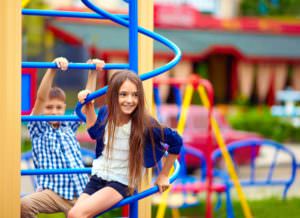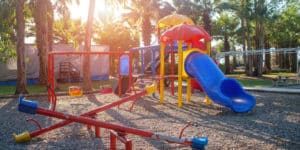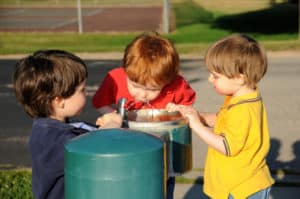
Schools are gradually returning to in-person learning thanks to the vaccination process. This is great news for children who will once again benefit from face-to-face contact with their teachers and interactions with their friends. We’re also entering the warm weather months, and the need to maintain safe social distancing practices will likely lead many schools to encourage outdoor play.
It’s important to remember that the outside temperature on a particular day must remain an important factor governing decisions about students’ ability to play outdoors. Extremely hot, sunny days place young children at serious risk of heatstroke and other heat-related illnesses. Therefore, it’s critical that your school takes the necessary steps to prevent these serious issues from developing.
There are various factors impacting the point at which it becomes too hot for children to play outside. These include:
Keep in mind that children rarely complain when they overheat, and they typically fail to take the actions necessary to self-regulate their body temperature. In addition, children absorb more heat than adults while sweating less. These factors create a greater risk that they’ll suffer heatstroke.
It’s a good idea to review local heat advisories on hot days. This will help you make decisions that keep your students safe and reduce the likelihood of heat-related illness.
 Most playgrounds function as serious heat radiators. Both the asphalt and playground equipment reach temperatures that far exceed the outside temperature, and this is particularly true on sunny days.
Most playgrounds function as serious heat radiators. Both the asphalt and playground equipment reach temperatures that far exceed the outside temperature, and this is particularly true on sunny days.
A research team from Columbia University measured the surface heat of playground asphalt at 134°F on a day when the air temperature was 91°F. Interestingly, the research team also found that AstroTurf gets even hotter than asphalt.
Playground equipment heats up quickly and retains this heat for prolonged periods. Not only will this increase a child’s risk of heat-related illness, but it also places them at risk of burn injuries. In California, an ABC News team worked with a University of California San Diego professor to evaluate the temperature of standard playground equipment. They determined that playgrounds act as mini heat islands:
All teachers and staff supervising outdoor activities must be educated about the warning signs of heat-related illness.
While heat cramps aren’t severe on their own, they’re typically a sign that a child is headed towards developing a more serious issue such as heat exhaustion or heatstroke. Children are particularly susceptible to heat cramps when they’re not staying hydrated. These brief, painful muscle cramps most commonly occur in the:
Heat exhaustion is more severe than heat cramps. It often develops when children become dehydrated while playing or exercising in a hot environment. Common symptoms include:
If heat exhaustion is left untreated, it can develop into heatstroke. This is a life-threatening medical emergency that requires immediate action. During heatstroke, the child’s body generates more heat than it’s able to release, resulting in a rapid rise in core body temperature. This can lead to devastating consequences such as brain damage or death if treatment isn’t administered promptly. Common symptoms include:
If a child exhibits signs of heatstroke, call 911 immediately and request emergency assistance. While you’re waiting for help:
 There are two components to helping kids stay cool on the playground. First, you need to implement policies that promote heat safety on school grounds. These policies should include:
There are two components to helping kids stay cool on the playground. First, you need to implement policies that promote heat safety on school grounds. These policies should include:
Second, you should consider modifications to your playground that will help kids stay cool. Some practical options include:
Portacool has been an industry leader in evaporative cooling technology for over 30 years. All of our evaporative coolers are made in our Center, Texas manufacturing facility. In addition, our evaporative media, made by our subsidiary company Kuul, is explicitly designed to meet the specifications of Portacool evaporative coolers, ensuring the most effective results. Kuul produces the only evaporative media manufactured in the United States.
Our Jetstream™ series and Cyclone™ series are both ideally suited to the needs of schools looking to provide a cool, comfortable environment that will keep kids safe on playgrounds. Our evaporative coolers come in a variety of sizes, ensuring you can find one to provide optimal results for the outdoor space you’re trying to cool. You can use our online tool to find the right Portacool for you.
Please visit a local retailer or contact us directly to learn more about Portacool evaporative coolers.